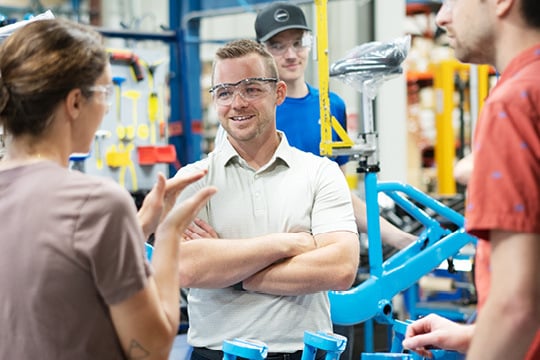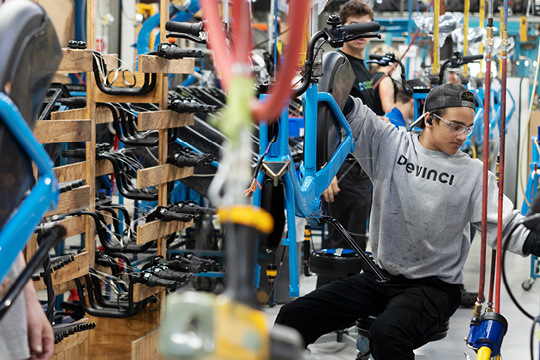Francis Morin, General Manager of Devinci Bikes, faced some of the unique challenges created by one of the most unimaginable situations of the 21st century: the COVID-19 pandemic. With the growing demand in the bicycle industry, BDC helped Francis find an ERP system that allowed him to achieve the kind of automation he envisioned and bring much of his production back to Quebec. Now, he can not only meet the increased demand, he can also set attainable goals and grow his business.
How this bicycle manufacturer overcame its productivity challenges
Francis Morin had hit a wall. Even though the pandemic led to an explosion in demand for bicycles from the Chicoutimi-based Devinci Bikes, the parts he needed to manufacture and assemble them were tied up on the other side of the Pacific.
“Tens of thousands of containers were stuck at different ports. This made it difficult to find containers to ship the parts we were purchasing in Asia,” explains Morin, General Manager at Devinci Bikes.
Not only was it difficult to arrange the transportation of goods, but the production capacity of the companies supplying parts in Asia was limited, particularly as a result of the measures intended to stop the spread of COVID-19. “Procurement lead times, historically about 120 days, inflated to over 700 days in some cases. Our teams had to plan and order our product lines up to two years in advance to reserve production time with our suppliers.”
The company also faced a significant labour shortage, coupled with a growing need for resources, which limited its own production capacity.
Despite these logistical and human resource problems, the company managed to stay on track and maintain a good pace of growth, by focusing in particular on improving its processes and productivity with the help of BDC Advisory Services.
The past two years have tested us as a team, and I now know that our company has emerged stronger to face future challenges.
Francis Morin
General Manager, Devinci Bikes
Navigating the supply chain
Devinci already had a considerable advantage over its competitors when it came to shipping.
Just before the pandemic, Morin had undertaken a major project to move a large portion of the company’s production back to Quebec. This made the company the largest bicycle manufacturer in Canada.
“We saw the value of doing the assembly and manufacturing here,” says Morin. “With regard to shipping, for example, we bring in our components in parts, rather than bringing in fully assembled bicycles, which means that we save 50% on the transportation capacity required.”
The company still had to find a way to get all the parts needed to build a bike.
The manufacturer first found companies that could store the components it was buying in Asia, while it figured out how to get them to Quebec for assembly.
Since the supplying companies did not want to keep the parts in their factories, they prioritized the selling of their products to customers who could move the stock. “As a result, we had to find local storage options to ensure our supply.”
Devinci also shifted some of its focus from international to North American markets, which simplified transportation management. In addition, it diversified its suppliers to ensure a steady stream of components.
“If you need 100 parts to make a bike, but you only have 95, your production is paralyzed,” notes Morin.
“With derailleurs for instance, sometimes there is no real alternative. Some cyclists want Shimano, period. But for handlebars, for example, we were able to find equivalents from other manufacturers.”
The company also ordered components in advance—many more than usual—he explains, to ensure supply.

Labour: a second challenge
Devinci’s decision to manufacture its frames and assemble its bicycles in North America also helped it respond to labour shortage challenges.
The company’s operations are separated into two main divisions: frame manufacturing and bicycle assembly. Because manufacturing was less affected by the supply issues in Asia, Devinci was able to reallocate some of its staff from manufacturing to assembly.
“Our most experienced employees made it possible for us to be nimble with our roles and improve the training process. It’s an advantage to have a production team that can work miracles. We made 40% of our sales in three months to make up for the delays at the start of the year.”
Devinci also stepped up its recruitment efforts, with the company looking internationally to fill key jobs, such as welders and machinists. Lastly, the company redesigned its factory to improve the flow of materials and, in turn, its efficiency.
“Thanks to all that, we will be doubling our assembly capacity to support the growth of Devinci and of our two major customers,” says Morin.

Automation plans
North American companies that want to remain competitive have no choice but to increase automation in their factories,” acknowledges Morin. Devinci is no exception.
For this reason, the manufacturer has launched a second phase for automating its production.
To improve the flow of materials and information, Devinci conducted a review of its factory layout. The company has put a priority on it being both an efficient and safe place for its employees.
“We have various projects that we want to pursue in the short term. Our investment plan is already underway, with a view to doubling production capacity within 12 to 18 months. We have also purchased equipment that will be essential for the implementation of our Devinci 4.0 factory strategy,” Morin explains.
This will help the manufacturer overcome labour shortages, reduce costs, increase efficiency and ensure even better quality for its customers.
As part of its automation philosophy, Devinci has installed a new ERP system; it has also established a new logistics centre to supply its additional assembly lines.
“This will enable us to gear up—because an ERP is the backbone of operations,” notes Morin. Among other things, the new system will be more intuitive and user-friendly, with an improved interface.
With the efforts it has made to increase efficiency and address its supply and labour issues, Devinci Bikes is on track for the future. And the future looks bright: the company expects to double its sales within five years.
Get inspired
Article | 8 min read
Breaking the glass ceiling in the construction industry. Discover Natasha Callender-Wilson's story.
Article | 5 min read
Turning recycling into riches is what Peter Olorundimu is all about.
Article | 3 min read
Driving AI innovation is what Raquel Urtasun, CEO at Waabi, is all about.
Article | 13 min read
Helping projects take flight in the North is what Kirt Ejesiak is all about.
Keep moving your business forward with our flexible financing solutions and expert advisory services
This site is protected by reCAPTCHA and the Google Privacy Policy and term of Service apply.





